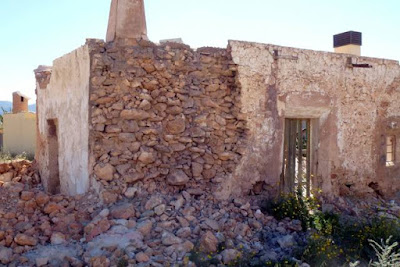On
the outskirts of the village we pass an abandonned Spanish military building.
In this area there are many such buildings, all associated with the gun
batteries on a headland several miles away that operated from the late 1920’s
to 1993. They all look like Foreign Legion filmset forts.
A
short way along the gravel road we spy a huge bright yellow mound, emitting a
sweet sharp smell. Rudi investigates and finds that it’s a pile of dumped minced-up
lemons. Just one whole specimen survives that Rudi has claimed. There are no
lemon trees within several miles so some processing plant has clearly
fly-tipped them.
But
let’s move on as we have three miles to go and some 800 feet of elevation to
climb before we drop down to the Custom House itself. This is the highest point
on the road from where we can now view the sea and rugged coastline. The road
surface is little used but quite good.
The
Custom House setting is idyllic. There is no natural water on this part of the
coast so perhaps the customs men had to make do with beer or wine. Working
conditions were tough then.
The
building itself is securely boarded up, presumably to prevent squatters, but is
in good condition. What a shame that it cannot be used as a walkers hostel, being
on a major coastal footpath route.
The
views from the large front patio area, railed off for safety, are spectacular. It
would be a wonderful location for backpackers and ramblers to spend time at.
To
one side of the building are several small stone structures that could be
animal shelters if they were larger. They aren’t shrines either – any guesses?
We
look along the coast path we now need to follow. It’s certainly picturesque,
but where’s the path? We are heading for the small bay just visible before
climbing up to the rocks on the skyline.
A
look back at the Custom House shows what an isolated place it is. Let’s hope
the customs officers had plenty of smugglers to catch to avoid boredom.
We
eventually find and follow the waymarked path to the beach where there are some
interesting rock formations on the exit track.
After
this, the going isn’t so easy on the ascent to the rocks. This is typically how
the path looks and was even steeper in parts.
We
plod on, to hit a point on the military road about 900 feet above sea level
where we had parked a second car. We can just pick out the beach, where we
started to climb, way below in the distance. That was some walk!






































